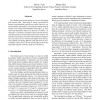Free Online Productivity Tools
i2Speak
i2Symbol
i2OCR
iTex2Img
iWeb2Print
iWeb2Shot
i2Type
iPdf2Split
iPdf2Merge
i2Bopomofo
i2Arabic
i2Style
i2Image
i2PDF
iLatex2Rtf
Sci2ools
ICDM
2006
IEEE
2006
IEEE
Turning Clusters into Patterns: Rectangle-Based Discriminative Data Description
The ultimate goal of data mining is to extract knowledge from massive data. Knowledge is ideally represented as human-comprehensible patterns from which end-users can gain intuitions and insights. Yet not all data mining methods produce such readily understandable knowledge, e.g., most clustering algorithms output sets of points as clusters. In this paper, we perform a systematic study of cluster description that generates interpretable patterns from clusters. We introduce and analyze novel description formats leading to more expressive power, motivate and define novel description problems specifying different trade-offs between interpretability and accuracy. We also present effective heuristic algorithms together with their empirical evaluations.
| Added | 11 Jun 2010 |
| Updated | 11 Jun 2010 |
| Type | Conference |
| Year | 2006 |
| Where | ICDM |
| Authors | Byron J. Gao, Martin Ester |
Comments (0)

